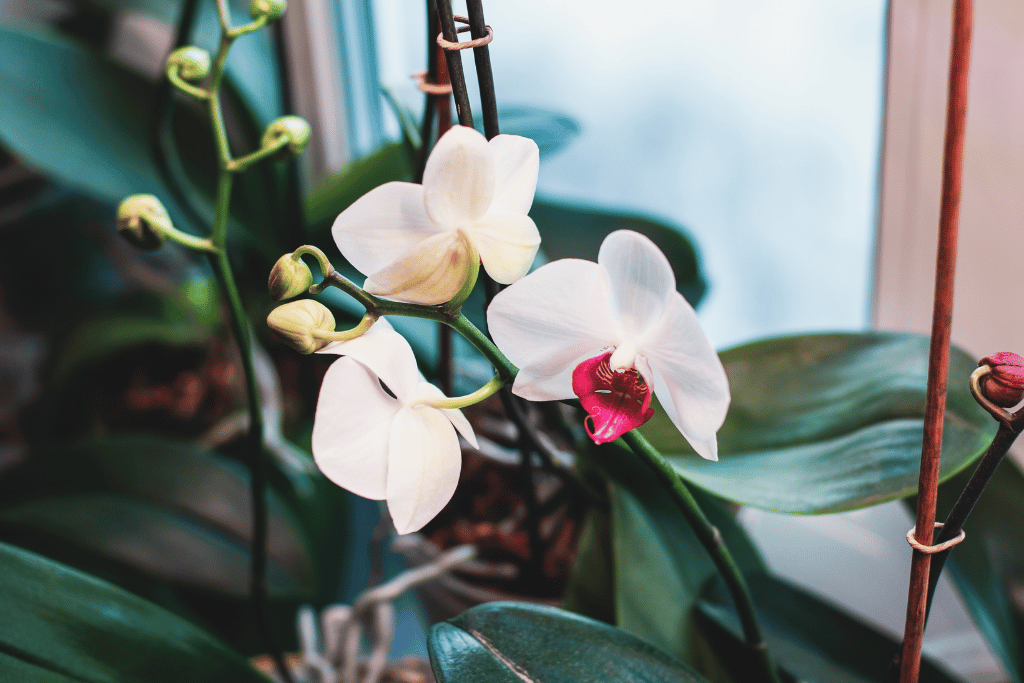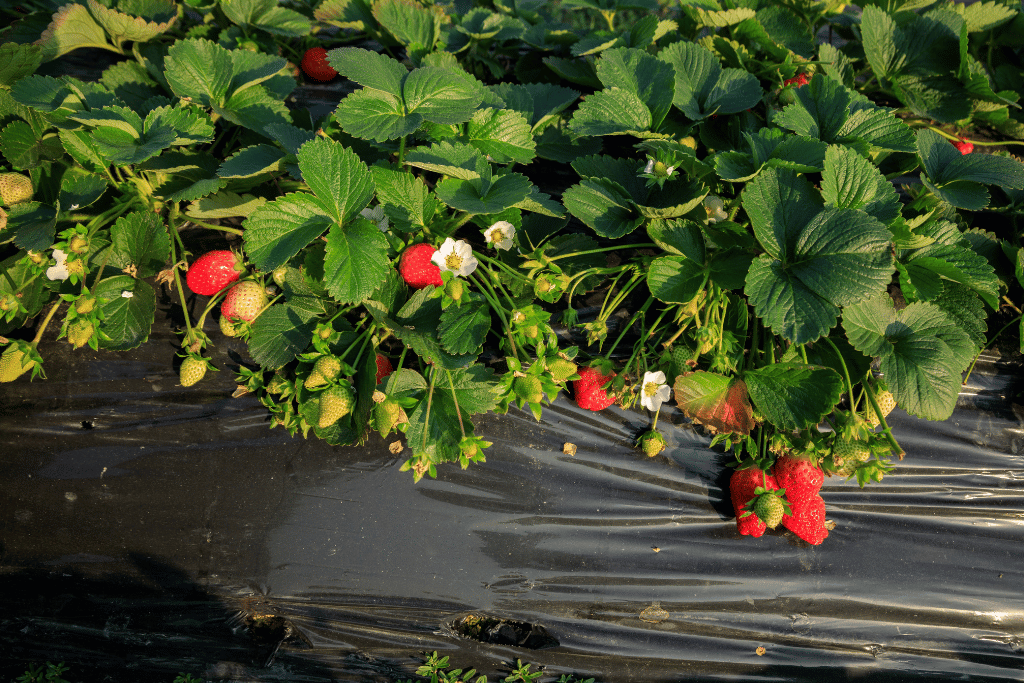Many people love orchids; they’re one of the most popular houseplants, and it’s for a good reason. They put out gorgeous flowers which can last for weeks, even months. Orchids aren’t just for the experienced plant grower; they’re for everyone! If you’re thinking of getting an orchid, you might wonder, ‘how long does an orchid bloom last?’. There are many different factors which influence this, which I’ll talk about in this article.
One of the most common species of orchids people buy (and are commercially available) is Phalaenopsis (Moth) orchids. Compared to other species, moth orchids are pretty hardy and are typically a good starting point for people wanting to get into caring for orchids. Including moth orchids, most orchids are perennials, meaning they live for more than one year (most can live around 10-15 years) and will rebloom every year given the proper care. Some other suitable species for beginners include Oncidium, Cattleya and Dendrobium. Dendrobium can handle varying levels of light, so it makes it ideal for people who don’t have the most space.
When starting out with orchids, I wouldn’t recommend going for any rarer species, as these typically are rare for a reason. Their conditions for care may be very specific, needing specialist equipment and tailored temperatures, light and chemicals to survive in a home. These are also a bit more expensive, and if you kill one, you will be very discouraged!

What Makes Orchids Special?
I think that the most interesting thing about orchids is the habitats they come from. The majority come from places such as tropical forests, semi-arid regions or tundras – and yet they can do perfectly fine in our homes with a bit of adjustment! Some orchids are epiphytic, too, meaning that they latch onto other organisms, such as trees and push out aerial roots, which draw in moisture and nutrients from the air. I bet your aglaonema can’t do that!
One of the more obvious things that make orchids unique is the flowers. On their flower spikes, orchids will produce breathtaking flowers which cascade down. Seeing multiple flower spikes on your orchid is a rewarding feeling, and it’s even better seeing them last for weeks or months, especially Phalaenopsis orchids.
Caring for Blooming Orchids
When I first got an orchid, it was in bloom. I had many other plants at the time, and I knew that orchids had a bit of a reputation for being slightly tricky to care for, so I was pretty worried that I’d kill them. However, it’s still here with me years later! Plants in bloom will demand a bit more from you, especially with water demand.
Watering
Let’s start off with watering. As mentioned above, plants in bloom have an increased water demand, as they need it to produce enough energy to keep the blooms going and produce seeds. So, when our orchids bloom, it’s likely that we might need to begin to water them a bit more frequently. I’m not particularly eager to water mine on a strict schedule, so I stick my finger an inch deep into the soil to check if it needs watering. I’ll hold off on watering if the substrate is still soggy until it dries out slightly. Though never let your plant’s soil get completely dry; otherwise, this will kill it exceptionally quickly.
Light
Let there be light! Seriously. When your orchids bloom, consider moving them to a position where they receive more light. It’s important to note, though, that it should not be receiving direct sunlight, only indirect or filtered light. In nature, orchids’ light is usually filtered by the dense tree canopy above, so they can’t handle direct sunlight as they’ll get sunburnt. While we can’t prevent this with sunscreen, we can by placing them in a position where they get around 6-9 hours of indirect/filtered light.
Fertilizing
Now, fertilizer. I’ve done quite a bit of research into this, and I’m still not sure how fertilizer can affect orchids that are in bloom! On other plants, it’s advised to stop fertilizing when the buds open to prolong the flowers. However, I’ve noticed that this doesn’t have much of an effect on orchids. Other growers have said that you can continue your fertilization regime as regular, which should be around once every month, helping your orchid get nutrients after it finishes blooming. Maybe you could try this yourself and see what the results are?
Temperature
Temperature is one of the most essential factors with orchids. Between 12-23 degrees is an optimal temperature range for an orchid. Though, it’s not really keeping the orchids in between this temperature range that is the problem for most growers. Instead, it’s the drastic temperature changes that they subject their orchids to. Orchids cannot handle big temperature drops associated with things like opening large windows or doors, so it’s best to position them away from these places. I keep mine on a north-facing windowsill, where the window is only opened in the summer when the temperatures are pretty warm.
Orchids that go through big temperature drops can become shocked, leading to the early dropping of flowers and the yellowing of stems and leaves, which we definitely don’t want.
Reblooming on Orchids
It’s always sad to see the blooms of your orchid eventually decay and fall off, but that’s just the life cycle of an orchid. Don’t worry, though, as you can get your orchid to rebloom in the future! If it’s a Phalaenopsis orchid, you might even get another bloom in the same year if you’re good with orchids.

We can do a few things to encourage our orchid to rebloom again, so let’s go over them.
- Repotting. Over the course of a few years, the substrate your orchid is potted in will eventually degrade in quality, meaning that it may not hold water as well or hold too much water. This is a problem for the orchid, and it might weaken it, leading to your orchid not being healthy enough to put out flowers. In this case, you’ll have to repot the orchid when it’s out of bloom, giving it a free-draining and airy mix such as bark, perlite or other substrates.
- Fertilizing. I can’t stress how vital feeding your orchid is – it provides it with tons of excellent nutrients which are necessary for your orchid’s health, such as nitrogen, phosphorous and potassium. Phosphorous will encourage the development of flower buds, dramatically increasing the chance of your orchid reblooming.
- Humidity. In their natural habitats, humidity can reach around 70-80%, so it’s crucial that we try and recreate this as best as possible at home. We can use humidifiers, misting or drip trays to do this. I use drip trays, but misting is also useful as long as you do it early enough in the day. Otherwise, the water will stay on the leaf overnight and rot it.
Read more deeply about the care for orchids.
So, how long does an orchid bloom last?
You can expect most blooms to last about 6-10 weeks. However, some may last a bit longer or won’t last as long. This will depend on the quality of care you give it, such as the watering, light, fertilizing and temperature. Orchids that are healthy and vigorous will be able to keep their blooms for more extended periods of time and are a lot more likely to rebloom compared to sick orchids, which might’ve suffered stress from these factors.
Frequently Asked Questions (FAQ)
What do you do with an orchid after the blooms fall off?
Once the blooms have fallen off your orchid, you should continue to care for it as usual. With the flower spikes, you can choose to either remove it, cut it back to a node or leave it intact, which may produce more blooms in the future, depending on the species. If you find that it’s causing more damage to the orchid than good, such as the yellowing of leaves or stems, then it’s wise to remove the flower spike. We don’t want to sacrifice the general health of our orchid for another bloom!
What is the lifespan of an orchid?
Generally, orchids can live for around 15-20 years. This will again depend on their environment and the care given. Potted orchids will usually last approximately 10-15 years compared to those in nature, but if you think that your orchid may be coming to the end of its life, why not propagate a new one? This is a very cheap way of getting a new orchid, and it’s almost like you’ll have a new generation of your previous orchid!
Do you still water orchids after flowering?
Once orchids have dropped their blooms, you should continue to water them like normal. Don’t start watering them less frequently or more frequently – use the finger in the soil trick to check for moisture. This is a pretty foolproof way of knowing when to water your orchid, and it helps to prevent underwatering or overwatering, which can severely stress the orchid out and prevent reblooming.
When do orchids flower?
Phalaenopsis orchids typically flower in late winter, losing their flowers in late spring to early summer. They’re lovely for adding a bit of color to your plant collection in the winter months! As I write this in late February, I have a flower spike full of open blooms and another one just about to open – it’s always a joy owning orchids.



